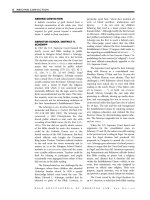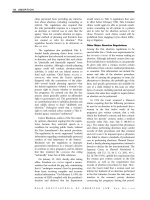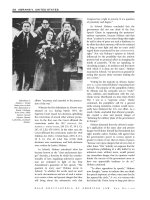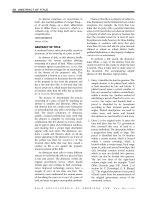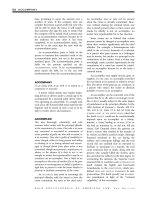Gale Encyclopedia Of American Law 3Rd Edition Volume 1 P9 pot
Bạn đang xem bản rút gọn của tài liệu. Xem và tải ngay bản đầy đủ của tài liệu tại đây (266.36 KB, 10 trang )
Examples of
acknowledgments
Short forms of acknowledgment
The forms of acknowledgment set forth in this section may be used and are sufficient for their respective purposes under any law of
this State. The forms shall be known as "Statutory Short Forms of Acknowledgment" and may be referred to by that name. The
authorization of the forms in this section does not preclude the use of other forms. [1969, c. 364 (new).]
1. Individual. For an individual acting in his own right:
State of
County of
The foregoing instrument was acknowledged before me this (date) by (name of person acknowledged).
(Signature of person taking acknowledgment)
(Title or rank)
(Serial number, if any)
[1969, c. 364 (new).]
2. Corporation. For a corporation:
State of
County of
The foregoing instrument was acknowledged before me this (date) by (name of officer or agent, title of officer or agent) of (name of
corporation acknowledging) a (state or place of incorporation) corporation, on behalf of the corporation.
(Signature of person taking acknowledgment)
(Title or rank)
(Serial number, if any)
[1969, c. 364 (new).]
3. Partnership. For a partnership:
State of
County of
The foregoing instrument was acknowledged before me this (date) by (name of acknowledging partner or agent), partner (or agent)
on behalf of (name of partnership), a partnership.
(Signature of person taking acknowledgment)
(Title or rank)
(Serial number, if any)
[1969, c. 364 (new).]
4. Principal. For an individual acting as principal by an attorney in fact:
State of
County of
The foregoing instrument was acknowledged before me this (date) by (name of attorney in fact) as attorney in fact on behalf of (name
of principal).
(Signature of person taking acknowledgment)
(Title or rank)
(Serial number, if any)
[1969, c. 364 (new).]
Acknowledgments
[
continued
]
68 ACKNOWLEDGMENT
GALE ENCYCLOPEDIA OF AMERICAN LAW, 3RD E DITION
ACCOUNTING of the new company’s profits for the
years it has been using the label. A court will
refuse the accounting, because by its acquies-
cence the competitor tacitly approved the use of
the label. The competitor, however, might be
entitled to an injunction barring the new
company from further use of its trademark if
it is so similar to the competitor’s label as to
amount to an infringement.
Similarly, the
INTERNAL REVENUE SERVICE (IRS)
may acquiesce or refuse to acquiesce to an
adverse
RULING by the U.S. TAX COURT or another
lower federal court. The IRS is not bound to
change its policies due to an adverse ruling
by a federal court with the exception of the
U.S. Supreme Court. The chief counsel of
the IRS may determine that the commissioner
of the IRS should acquiesce to an adverse
decision, however, thus adopting the ruling as
the policy of the IRS. The decision whether
to acquiesce to an adverse ruling is published by
the Internal Revenue Service as an Action on
Decision.
Acquiescence is not the same as
LACHES,
a failure to do what the law requires to
protect one’s rights, under circumstances mis-
leading or prejudicing the person being sued.
Acquiescence relates to inaction during the
performance of an act. In the example given
above, the failure of the competitor’s general
counsel to object to the use of the label and to
the registration of the label as a trademark in
the Patent and Trademark Office is acquies-
cence. Failure to
SUE the company until after
several years had elapsed from the first time the
label had been used is laches.
ACQUIRED IMMUNE DEFICIENCY
SYNDROME
A disease caused by the human immunodeficiency
virus (HIV) that produces disorders and infections
that can lead to death.
Acquired immune deficiency syndrome
(AIDS), a fatal dis ease t hat atta cks the body ’s
immune system making it unable to resist infec-
tion, is caused by the human immunodeficiency
virus (HIV), which is communicable in some
bodily fluids and transmitted primarily through
sexual be havior and i ntravenous drug u se.
The United States struggled to cope with
AIDS from the early 1980s until the late 1990s,
when new drug therapies started to extend the
length and quality of life for many people with
5. Public officer. By any public officer, trustee or personal representative:
State of
County of
The foregoing instrument was acknowledged before me this (date) by (name and title of position).
(Signature of person taking acknowledgment)
(Title or rank)
(Serial number, if any)
[1969, c. 364 (new).]
Section History:
PL 1969, Ch. 364, § (NEW).
The Revisor's Office cannot provide legal advice or interpretation of Maine law to the public. If you need legal advice, please consult a
qualified attorney.
Office of the Revisor of Statutes
7 State House Station
State House Room 108
Augusta, Maine 04333-0007
This page created on: 2003-03-13
Acknowledgments
Examples of
acknowledgments
(continued)
ILLUSTRATION BY GGS
CREATIVE RESOURCES.
REPRODUCED BY PER-
MISSION OF GALE, A
PART OF CENGAGE
LEARNING.
GALE ENCYCLOPEDIA OF AMERICAN LAW, 3
RD E DITION
ACQUIRED IMMUNE DEFICIENCY SYNDROME 69
AIDS. Since the beginning, AIDS and its
resulting epidemic in the United States have
raised a great number of legal issues, which are
made all the more difficult by the nature of the
disease. AIDS is a unique killer, but some of its
aspects are not: epidemics have been seen
before; other sexually transmitted diseases have
been fatal. AIDS is different because it was
discovered in—and in the United States
still predominantly afflicts—unpopular social
groups: gay men and drug users. This fact has
had a strong impact on the shaping of AIDS
law. Law is often shaped by politics, and AIDS is
a highly politicized disease. The challenge in
facing an epidemic that endangers everyone is
complicated by the stigma attached to the
people most likely to be killed by it.
Epidemics have no single answer beyond a
cure. Because no cure for AIDS exists, the law
continues to grapple with a vast number of
problems. The federal government has addressed
AIDS in two broad ways: by spending money on
research and treatment of the disease and by
prohibiting unfairness to people with HIV or
AIDS. It has funded medical treatment, research,
and public education, and it has passed laws
prohibiting
DISCRIMINATION against people who
are HIV-positive or who have developed AIDS.
States and local municipalities have joined
in these efforts, sometimes with federal help.
In addition, states have criminalized the act of
knowingly transmitting the virus through sexual
behavior or blood donation. The courts, of
course, are the decision makers in AIDS law.
They have heard a number of cases in areas that
range from employment to education and from
crimes to torts. Although a body of
CASE LAW has
developed, it remains relatively new with respect
to most issues, and controversial in all.
AIDS and the Federal Government
Political attitudes towar d AIDS have gone
through dra matically different phases. In the
early 1980s, it was dubbed “the gay disease” and
as such was easy for lawmakers to ignore. No
one hurried to fund research into a disease
that seeme d to be killing only members of a
historically unpopular group. When it was not
being ignored, some groups dismissed AIDS as a
problem that homosexuals deserved, perhaps
brought on them by divine intervention.
Discriminatory action matched this talk as gay
men lost jobs, housing, and medical care. AIDS
activists complained bitterly about the failure
of most U.S . citizens to be concerned. Public
opinion only began to shift in the late 1980s,
largely through awareness of highly publicized
cases. As soon as AIDS had a familiar or more
mainstream face, it became harder to ignore ;
when it became clear that heterosexuals were
The AIDS quilt,
on display in
Washington, D.C.,
has become a well-
known symbol of
support for AIDS
victims and their
families. Families and
supporters of AIDS
victims create a panel
to commemorate a
person’s life; each
panel is then joined
with others from
around the country.
LEE SNIDER/CORBIS.
GALE ENCYCLOPEDIA OF AMERICAN LAW, 3RD E DITION
70 ACQUIRED IMMUNE DEFICIENCY SYNDROME
also contracting the disease, the epidemic
acquired higher priority.
By the late 1980s much of the harshness in
public debate had diminished. Bot h liberals and
conservatives lined up to support
LEGISLATIVE
solutions. President RONALD REAGAN left office
recommending increases in federal funding for
medical research on AIDS. Already the amount
spentinthisareahadrisenfrom$61millionin
1984 to nearly $1.3 billi on in 198 8. President
GEORGE H.W. BUSH tookamoreactiveapproachand
in 1990 signed two new bills into law. One was the
Ryan White C omprehensive AIDS Resources
Emergency (CARE) Act (Pub. L. No. 101-381,
104 Stat. 576), which provides much-needed
money for states to spend on treatment. The
other wa s the groundbreaking Americans wi th
Disabilities Act (ADA) (42 U.S.C.A. §§ 12112–
12117), which has proved to be the mos t effective
weapon against the disc riminat ion that indivi dua ls
with the disease routinely suffer. Bush also hurried
approval by the
FOOD AND DRUG ADMINISTR ATION for
AIDS-related drugs. Though he supported A mer-
icans with the disease, Bush agreed to a contro-
versial ban by Congress on travel an d
IMMIGRATION
to the United States for people with HIV.
Like his predecessors, President
BILL CLINTON
called for fighting the disease itself, rather than the
people afflicted with it. In 1993 he appointed the
first federal AIDS policy coordinator. He fully
funded the Ryan White Care Act, increasing
government support by 83 percent, to $633
million, and also increased funding for AIDS
research, prevention, and treatment by 30 percent.
These measures met most of his campaign
promises on AIDS. He reneged on one: despite
vowing to lift the ban on HIV-positive
ALIENS,he
signed
LEGISLATION continuing it. In addition, he
met a major obstacle on another proposal:
Congress failed to pass his health care reform
package, which would have provided health
coverage to all U.S. citizens with HIV, delivered
drug treatment against AIDS, on demand, to
intravenous drug users, and prohibited health
plans from providing lower coverage for AIDS
than for other life-threatening diseases.
President
GEORGE W. BUSH also passed
initiatives that allocated federal funds toward
fighting the aids epidemic. In 2003 he an-
nounced the President’s Emergency Plan for
AIDS Relief (PEPFAR), in which he called upon
congress to pass legislation that would appro-
priate $15 billion over five years to support
international AIDS prevention and the purchase
of anti-viral drugs. The largest share of the
money was contributed directly by the United
States to other countries, such as through
programs sponsored by the U.S. Agency for
International Development. The proposal
accounted for almost half the money in a global
fund committed to fight HIV and AIDS. As the
initial plan expired in the 2008 fiscal year,
Congress approved, and President George W.
Bush signed into law legislation that extended
the plan another five years and authorized an
additional $48 billion in funding. Specifically,
the funds from PEPFAR are designated to
help provide treatment to at least 3 million
individuals with HIV, prevent approximately
12 million new infections, and provide care for
12 million people infected.
President
BARACK OBAMA in his 2008 presi-
dential campaign pledged to develop and
Total
Male
Femal
e
New AIDS Cases Reported, 1993 to 2007
0 20,000 40,000 60,000 80,000 100,000 120,000
9,579
26,355
35,954
2007
10,744
29,766
40,540
2005
11,211
30,851
42,062
2003
11,082
31,901
42,983
2001
10,780
35,357
46,137
1999
13,105
47,056
60,161
1997
13,764
59,616
73,380
1995
16,824
89,165
105,990
1993
Year
Number of AIDS cases
SOURCE: Centers for Disease Control and Prevention, National Center for
HIV/AIDS, Viral He
p
atitis, STD, and TB Prevention.
ILLUSTRATION BY GGS
CREATIVE RESOURCES.
REPRODUCED BY
PERMISSION OF GALE,
A PART OF CENGAGE
LEARNING.
GALE ENCYCLOPEDIA OF AMERICAN LAW, 3
RD E DITION
ACQUIRED IMMUNE DEFICIENCY SYNDROME 71
implement a comprehensive national HIV/
AIDS strategy designed to not only reduce
HIV infections, but also to increase access to
care and treatment and reduce HIV-related
health disparities. He specifically pledged to
expand funding for research and prevention of
HIV, including a vaccine and a microbicide
product for women to apply topically to prevent
the transmission of HIV and other infections.
He has further pledged to work toward improv-
ing the quality of life for those living with HIV
and supports increased funding for adequate and
safe housing for individuals living with HIV. In
April 2009 President Obama’s Administration
announced it was implementing a five-year
national communication campaign with the
DEPARTMENT OF HEALTH AND HUMAN SERVICES
(HHS) and the Centers for Disease Control
and Prevention (CDC), known as Act Against
AIDS, that would refocus the national attention
of the HIV crisis in the United States. The
campaign was in part a response to data released
by the CDC in 2008, which estimated that
approximately 56,000 Americans become
infected with HIV each year and more than
14,000 Americans die with AIDS each year.
AIDS and Public Life
Having HIV is not a sentence to remove oneself
from society. It does not limit a person’sphysical
or mental abilities. Only later, when symptoms
develop—as long as ten years from the time of
infection—does the disease become increasingly
debilitating. In any event, people who are HIV-
positive and AIDS-symptomatic are fully able to
work, play, and participate in daily life. Moreover,
their rights to do so are the same as anyone else’s.
The chief barrier to a productive life often comes
less from HIV and AIDS than from the fear,
SUSPICION, and open hostility of others. Because
HIV cannot be transmitted through casual
contact, U.S. law has moved to defend the
CIVIL
RIGHTS
of those individuals with the disease.
AIDS in the Workplace The workplace is a
common battleground. Many people with AIDS
have lost their jobs, been denied promotions,
or been reassigned to work duties that remove
them from public contact. During the 1980s this
discrimination was fought through lawsuits based
on older laws designed to protect the disabled.
Plaintiffs primarily used the Rehabilitation Act of
1973 (29 U.S.C.A. § 701 et seq.), the earliest law of
this type. But the Rehabilitation Act has a limited
scope: it applies only to federally funded work-
places and institutions and says nothing about
those who do not receive government money.
Thus, for example, the law was helpful to a
California public school teacher with AIDS who
sued for the right to resume teaching classes
(Chalk v. United States district court, 840 F.2d 701
[9th Cir. 1988]), but it would be of no use to a
worker in a private business.
With passage of the ADA in 1990, Congress
gave broad protection to people with AIDS who
work in the private sector. In general, the ADA is
designed to increase access for disabled persons,
and it also forbids discrimination in hiring or
promotion in companies with 15 or more
employees. Specifically, employers may not
discriminate if the person in question is otherwise
qualified for the job. Moreover, they may not use
tests to screen out disabled persons, and they
must provide reasonable accommodation for
disabled workers. The ADA, which took effect
in 1992, quickly emerged as the primary means
for bringing AIDS-related discrimination law-
suits. From 1992 to 1993, more than 330
complaints were filed with the U.S.
EQUAL
EMPLOYMENT OPPORTUNITY COMMISSION
(EEOC),
which investigates charges before they can be
filed in court. Given the lag time needed for
EEOC investigations, those cases started appear-
ing before federal courts in 1994 and 1995.
AIDS and Health Care Closely related to w ork
is the issue of health care. In some cases, the two
overlap:
HEALTH INSURANCE, SOCIAL SECURITY, and
DISABILITY benefits for people with AIDS were
often hard to obtain during the 1980s. Insur-
ance was particularly difficult because employ-
ers feared rising costs, and insurance companies
did not want to pay claims. To avoid the costs of
AIDS, insurance companies used two traditional
industry techniques: they attempted to exclude
AIDS coverage from general policies, and they
placed caps (limits on benefits payments) on
AIDS-related coverage. State regulations largely
determine whether these actions were permissi-
ble. In New York, for example, companies that
sell general health insurance policies are for-
bidden to exclude coverage for particular
diseases. Caps have hurt AIDS patients because
their treatment can be as expensive as that for
cancer or other life-threatening illnesses. Insur-
ance benefits can be quickly exhausted—in fact,
AIDS usually bankrupts people who have the
disease. The problem is compounded when
GALE ENCYCLOPEDIA OF AMERICAN LAW, 3RD E DITION
72 ACQUIRED IMMUNE DEFICIENCY SYNDROME
employers serve as their own health insurers. In
McGann v. H&H Music Co., 946, F.2d 401 (5th
Cir. [1991]), a federal court ruled that such
employers could legally change their policies to
reduce coverage for workers who develop
expensive illnesses such as AIDS.
In January 1995 the
SETTLEMENT in a lawsuit
brought by a Philadelphia construction worker
with AIDS illustrated that the ADA could be
used to fight caps on coverage. In 1992 the joint
union-management fund for the Laborers’
District Council placed a $10,000 limit on AIDS
benefits, in stark contrast to the $100,000
allowed for other catastrophic illnesses. At that
time, the fund said the cap on AIDS benefits
was designed to curb all health costs. In 1993
the EEOC ruled that the fund violated the ADA,
and, backed by the AIDS Law Project of
Philadelphia, the worker sued. Rather than fight
an expensive lawsuit, the insurance fund settled:
under the agreement, it extended coverage for
all catastrophic illnesses to $100,000. Hailing
the settlement as a major blow against wide-
spread discrimination in insurance coverage,
the law project’s executive director, Nan Feyler,
told the Philadelphia Inquirer, “You can’t single
out someone based on a stereotype.”
In other respects, health care is a distinct
area of concern for AIDS patients and health
professionals alike. Discrimination has often
taken place. State and federal statutes, including
the Rehabilitation Act, guarantee access to
health care for AIDS patients, and courts have
upheld that right. In the 1988 case of Doe v.
Centinela Hospital, 57 U.S.L.W. 2034 (C.D.
Cal.), for example, an HIV-infected person with
no symptoms was excluded from a federally
funded hospital residential program for drug
and alcohol treatment because health care
providers feared exposure to the virus. The case
itself exposed the irrationality of such discrimi-
nation. Although its employees had feared HIV,
the hospital argued in court that the lack of
symptoms meant that the patient was not
disabled and thus not protected by the Rehabil-
itation Act. A federal trial court in California
rejected this
ARGUMENT, RULING that a refusal to
grant services based solely on fear of contagion
is discrimination under the Rehabilitation Act.
Other actions during the 1990s have relied
upon the ADA. In 1994 the U.S.
DEPARTMENT OF
JUSTICE
reached a settlement in a lawsuit with the
city of Philadelphia that ensures that city
employees will treat patients with AIDS. The
first settlement in a health care–related ADA
suit, the case arose out of an incident in 1993,
when an HIV-positive man collapsed on a
Philadelphia street. Emergency medical workers
not only refused to touch him but told him to
get on a stretcher by himself. The man sued. In
settling the case, the city agreed to begin an
extensive training program for its 900 emergen-
cy medical technicians and 1,400 firefighters.
In addition, officials paid the man $10,000 in
COMPENSATORY DAMAGES and apologized. The
Department of Justice viewed the suit as an
important test of the ADA. Assistant Att orney
General James Turner said the settlement would
“send a clear message to all cities across the
nation that we will not tolerate discrimination
against persons with AIDS.”
Health care professionals are not the only
ones with concerns about HIV transmission.
Patients may legitimately wonder whether their
doctors are infected. During the early 1990s, the
medical and legal communities debated whether
HIV-positive doctors have a duty to inform
their patients of the illness. According to the
CDC, the risk of HIV transmission from health
care workers to patients is very small when
recommended infection-control procedures are
followed, yet this type of transmission has
occurred. The first cases of patients contracting
HIV dur ing a medical
PROCEDURE were reported
in 1991: Dr. David J. Acer, a Florida dentist
with AIDS, apparently transmitted HIV to five
patients. One was Kim berly Bergalis, age
twenty-three, who died as a result. Before her
death, Bergalis brought a
CLAIM against the
dentist’s professional
LIABILITY insurer, contend-
ing that it should have kno wn that Acer had
AIDS and effectively barred him from operating
by refusing to issue him a
MALPRACTICE insurance
policy. Bergalis’s claim was settled for $1
million. A second claim by Bergalis, against
the insurance company that recomme nded Acer
to her, was settled for an undisclosed amount.
SincetheBergaliscase,manyU.S.dentists,
physicians, and surgeons with AIDS have begun
disclosing their status to their patients. Faya v.
Almaraz, 329 Md. 435, 620 A.2d 327 (Md. 1993),
illustrates the consequences of not doing so. In
Faya th e court held that an HIV-positive doc tor
has the legal duty to disclose t his medical condition
to patients and that a failure to inform can lead to
GALE ENCYCLOPEDIA OF AMERICAN LAW, 3RD E DITION
ACQUIRED IMMUNE DEFICIENCY SYNDROME 73
a NEGLIGENCE action, even if the patients have
not been infected by the virus. The doctor’spatient
did not contract HIV but did suffer emotionally
from a fear of having done so. The unanimous
decision held that patients can be compensated
for their fears. Although this case dealt specifical-
ly with doctor-patient relationships, others have
concerned a variety of relationships in which the
fear of contracting AIDS can be enough for a
PLAINTIFF to recover damages.
Routine HIV-testing in healthcare facilities
also raises legal issues. Most people who are HIV-
positive want this information kept confidential.
Facilities are free to use HIV testing to control the
infection but in most states only with the patient’s
INFORMED CONSENT. Some states, such as Illinois,
require written consent. The level of protection
for medical records varies from state to state.
California, for example, has broad protections;
under its statutes, no one can be compelled to
provide information that would identify anyone
who is the subject of an HIV test. However, every
state requires that AIDS cases be reported to the
CDC, which tracks statistics on the spread of
HIV. Whether the name of an HIV-infected
person is reported to the CDC depends on state
laws and regulations.
AIDS and Educati on Issues in the field of
education include the rights of HIV-positive
students to attend class and of HIV-positive
teachers to teach, the confide ntiality of HIV
records, and how best to teach young people
about AIDS. A few areas have been settled in
court: for example, the right of students to
attend classes was of greater concern in the early
years of the epidemic and later ceased to be a
matter of dispute.
Certain students with AIDS may assert their
right to public education under the Education
for All Handicapped Children Act of 1975
(EAHCA), but the law is only relevant in cases
involving special education programs. More
commonly, students’ rights are protected by
the Rehabilitation Act. Perhaps the most
important case in this area is Thomas v.
Atascadero Unified School District, 662 F. Supp.
376 (C.D. Cal. 1986), which illustrates how far
such protections go. Thomas involved an
elementary school student with AIDS who had
bitten another youngster in a fight. Based on
careful review of medical evidence, the U.S.
District Court for the Central District of
California concluded that biting was not proved
to transmit AIDS, and it ordered the school
district to readmit the girl. Similarly, schools
that excluded teachers with AIDS have been
successfully sued on the ground that those
teachers pose no threat to their students or
others and that their right to work is protected
by the Rehabilitation Act, as in Chalk.
Confidentiality relating to HIV is not
uniform in schools. Some school districts
require rather broad dissemination of the
information; others keep it strictly private. In
the mid-1980s the New York City Board of
Education adopted a policy that no one in any
school would be told the identities of children
with AIDS or HIV infection; only a few top
administrators outside the school would be
informed. The policy inspired a lawsuit brought
by a local school district, which argued that the
identity of a child was necessary for infection
control (District 27 Community School Board v.
Board of Education, 130 Misc. 2d 398, 502 N.Y.
S.2d 325 [N.Y. Sup. Ct. 1986]). The trial court
rejected the argument on the basis that numer-
ous children with HIV infection might be
attending school, and instead noted that
universal precautions in responding to blood
incidents at school would be more effective than
the revelation of confidential information.
Schools play a major role in the effort to
educate the public on AIDS. Several states have
mandated AIDS prevention instruction in their
schools. But the subject is controversial: It
evokes personal, political, and moral reactions
to sexuality. Responding to parental sensitivi-
ties, some states have authorized excused
absences from such programs. The New York
State
EDUCATION DEPARTMENT faced a storm of
controversy over its policy of not allowing
absences at parental discretion. Furthermore, at
the local and the federal levels, some conserva-
tives have opposed certain kinds of AIDS
education. During the 1980s those who often
criticized liberal approaches to sex education
argued that AIDS materials should not be
explicit, encourage sexuality, promote the use
of contraceptives, or favorably portray gays and
lesbians. In Congress lawmakers attached
amendments to appropriations measures (bills
that authorize the spending of federal tax
dollars) that mandate that no federal funds
may be used to “promote homose xuality.” In
response the CDC adopted regulations that
prohibit spending federal funds on AIDS
GALE ENCYCLOPEDIA OF AMERICAN LAW, 3RD E DITION
74 ACQUIRED IMMUNE DEFICIENCY SYNDROME
education materials that might be found offen-
sive by some members of certain communities.
Despite the controversy, some communities
have taken radical steps to halt the spread of
AIDS. In 1991 and 1992 the school boards of
New York City, San Francisco, Seattle, and Los
Angeles voted to make condoms available to
students in their public high-school systems.
AIDS and Private Life
Although epidemics are public crises, they begin
with individuals. The rights of people who have
AIDS and those who do not are often in
contention and seldom more so than in private
life. It is no surprise that people with HIV
continue having sex, nor is it a surprise that this
behavior is, usually, legal. Unfortunately, some
do so without knowing they have the virus. Even
more unfortunately, others do so in full knowl-
edge that they are HIV-positive but without
informing their partners. This dangerous behav-
ior has opened one area of AIDS law that affects
individuals: the legal duty to warn a partner
before engaging in behavior that can transmit the
infection. Courts recognized a similar duty long
before AIDS ever appeared, with regard to other
sexually transmitted diseases.
A failure to inform in AIDS cases has given
rise to both civil and criminal lawsuits. One
such case was brought by Mark Christian, the
lover of actor Rock Hudson, against Hudson’s
estate. Christian won his suit on the ground that
Hudson had concealed his condition and contin-
ued their relationship, and the jury returned a
multi-million-dollar
VERDICT despite the fact that
there was no evidence that Christian had been
infected. Another case was brought in Oregon in
1991, when criminal charges were filed against
Alberto Gonzalez for knowingly spreading HIV
by having sex with his girlfriend. After Gonzalez
pleaded
NO CONTEST to third-degree ASSAULT (a
felony) and to two charges of recklessly endan-
gering others, he received an unusual sentence:
the court ordered him to abstain from sex for five
years and placed him under
HOUSE ARREST for six
months. Although such convictions are increas-
ingly common, courts have also recognized that
not knowing one has HIV can be a valid defense.
In C. A. U. v. R. L., 438 N.W.2d 441 (1989), for
example, the Minnesota Court of Appeals
affirmed a trial court’s finding that the plaintiff
could not recover damages from her former
fiancé, who had unknowingly given her the virus.
State Legislation and the Courts To stem
transmission of HIV, states have adopted several
legal measures. Two states attempted to head off
the virus at the pass: Illinois and Louisiana at
one point required HIV blood testing as a
prerequisite to getting a
MARRIAGE license. Both
states ultimately repealed these statutes because
they were difficult to enforce; couples simply
crossed state lines to be married in neighboring
states. Several states have taken a less stringent
approach, requiring only that applicants for a
marriage license be informed of the availability—
and advisability—of HIV tests. More common-
ly, states criminali ze sexual behavior that ca n
spread AIDS. Michigan l aw mak es it a felony
for an HIV- or AIDS-infected person to engage
in sex without first informing a partner of
the infection. Florida law provides for the
prosecution of any HIV-positive person com-
mitting
PROSTITUTION,anditpermitsRAPE
victims to demand that their attackers undergo
testing. Indiana imposes penalties on persons
who recklessly or knowingly donate blood or
semen with th e knowledge that they are HIV-
positive.
Older state laws have also been applied to
AIDS. Several states have statutes that make it a
criminal of fense for a person with a contagious
disease—including a sexually transmitted
disease—to willfully or knowingly expose anoth-
er person to it, and some have amended these
laws specifically to include AIDS. In addition, in
many states, it has long been a crime to
participate in an act of
SODOMY. The argument
that punishing sodomy can stem HIV transmis-
sion was made in a case involving a Missouri
sodomy statute specifically limited to homosex-
ual conduct. In State v. Walsh, 713 S.W.2d 508
(1986), the Missouri Supreme Court upheld the
statute after finding that it was rationally related
to the state’s legitimate interest in protecting
public health. Other AIDS-related laws have
been invalidated in court challenges: for exam-
ple, in 1993 a U.S. district judge struck down a
1987 Utah statute that invalidated the marriages
of people with AIDS, ruling that it violated the
ADA and the Rehabilitation Act.
Sex is only one kind of be havior that has
prompted criminal prosecution related to AIDS.
Commonly, de fendants i n AIDS cases have been
prosecuted for assault. In United St ates v. Moor, 846
F.2d 1163 (8th Cir., 1988), U.S. Court of Appeals
for the Eighth Circuit upheld the conviction of an
GALE ENCYCLOPEDIA OF AMERICAN LAW, 3RD E DITION
ACQUIRED IMMUNE DEFICIENCY SYNDROME 75
HIV-infected prisoner found guilty of assault with a
deadly weapon —his teeth—for biting two prison
guards during a struggle. T eeth were also the subject
of a trial in Brock v. State, 555 So. 2d 285 (1989), but
the Alabama CourtofCriminal A ppeals refused to
regard them as a dangerous weapon. In State v.
Haines, 545 N.E. 2d 834 (2d Dist. 1989), the
Indi ana Court of Appeals affirmed a conviction
of attempte d
MURDER against a man with AIDS
who had slash ed his wrists to commit
SUICIDE;
when police officers and paramedics refused to
let hi m die, he began to spit, bite, scratch, and
throw blood.
Civil Litigat ion
TORT LAW has seen an explo-
sion of AIDS-related suits. This area of law is
Reading, Writing, and AIDS
T
eaching young people about AIDS is
an enormously popular idea. Since
the late 1980s, Gallup Polls have revealed
that over 90 percent of respondents think
public schools should do so. Agreement
ends there, however. In the 1990s more
angry debate focused on AIDS education
than on any issue facing schools since
court-ordered busing in the 1970s. The
core question of the debate is simple:
What is the best way to equip students to
protect themselves from this fatal dis-
ease? The answers may be miles apart.
For one side, “equipping” means advo-
cating the only sure means of protection,
sexual and drug abstinence. For the
other, it means supporting abstinence
along with knowledge of sexual practices,
the use of clean drug needles, and the use
of prophylactics (condoms), which are
distributed in some schools. Between
these positions lie a great many issues
of disagreement that have bitterly divided
school districts, provoked lawsuits, and
cost high-ranking Washington, D.C.,
officials their jobs.
Sex is an old battleground in public
education. Liberals and conservatives
argued over it in the decade following
the sexual revolution of the 1960s,
initially over whether sexual issues
should be discussed in schools. After
all, earlier generations who went to
public schools learned mainly about
reproductive organs. As new classes
began appearing in the late 1970s,
children learned about the sexual choices
people make. If liberals appeared to win
the “sex ed.” debate, growing social
problems helped: rises in teen pregnan-
cies and sexually transmitted diseases
secured a place for more explicit school
health classes. The much greater threat of
AIDS pushed state legislatures into
action. By the mid-1990s AIDS preven-
tion classes had been mandated in at least
34 states and recommended in 14. But
the appearance of even more explicit
teaching has reinvigorated the sex ed.
debate.
Supporters of a comprehensive ap-
proach say AIDS demands frankness.
Originating in comprehensive sex ed.
theory, their ideas also came from
pacesetting health authorities such as
former
SURGEON GENERAL C. Everett Koop.
Arguing in the mid-1980s that AIDS
classes should be specific and detailed
and taught as early as kindergarten, Koop
countered conservative arguments by
saying, “Those who say ‘I don’t want
my child sexually educated’ are hiding
their heads in the sand.” This position
holds that educators are obligated to
teach kids everything that can stop the
spread of the disease. “What is the moral
responsibility?” Jerald Newberry, a
health coordinator of Virginia schools,
asked the Washington Times in 1992. “I
think it’s gigantic.” Abstinence is a part
of this approach, but expecting teens to
refrain from having sex was considered
by many to be unrealistic given some
studies that show that nearly three out
of four high school students have had
sex before graduation. Thus, the
comprehensive curriculum might well
include explaining the proper use of
condoms, discussing homosexual prac-
tices, describing the
STERILIZATION of drug
needles, and so on.
Abstinence-only adherents think be-
ing less frank is being more responsible.
They view sexuality as a moral issue
properly left for parents to discuss with
their children and one that lies beyond
the responsibilities of schools. The con-
servative columnist Cal Thomas spoke
for this viewpoint when he argued that
parents “have lost a significant right to
rear their children according to their
own moral standards.” Other objections
come from religious conservatives who
oppose any neutral or positive discussion
of homosexuality. Koop, for example,
was blasted for allegedly “sponsoring
homosexually oriented curricula” and
“teaching
BUGGERY in the 3rd grade.” In
addition to voicing moral objections,
critics say comprehensive sex ed. is
generally a failure because it encourages
a false sense of security among teens
that leads to experimentation with sex or
drugs. “We have given children more
information presumably because we
think it will change their behavior, and
yet the behavior has gotten worse, not
better,” said Gary Bauer, president of the
Family Research Council.
Each side accuses the other of
deepening the crisis. Comprehensive
approach supporters think abstinence-
only backers are moral censors, indiffer-
ent to pragmatic solutions. The liberal
GALE ENCYCLOPEDIA OF AMERICAN LAW, 3RD E DITION
76 ACQUIRED IMMUNE DEFICIENCY SYNDROME
used to discourage individuals from subjecting
others to unreasonable risks and to compensate
those who have been injured by unreasonably
risky behavior. The greatest number of AIDS-
related liability lawsuits has involved the receipt
of HIV-infected blood and blood products.
A second group has concerned the sexual
transmission of HIV. A third group involves
AIDS-related psychic distress. In these cases,
plaintiffs have successfully sued and recovered
damages for their fear of having contracted HIV.
Advances in Treatment Though the search
for an AIDS vaccine has occupied many
researchers, no significant breakthroughs have
appeared. However, other researchers have
concentrated on ways of controlling AIDS
People for the American Way attacked “a
growing wave of
CENSORSHIP ravaging
sexuality education” that promotes only
“narrow” curricula. It mocked such
abstinence-only programs as Teen Aid
and Sex Respect, both of which have
brought
THREATS of legal action from the
AMERICAN CIVIL LIBERTIES UNION and
Planned Parenthood. The conservative
American Enterprise Institute asserted
that liberal programs only prod students
toward bad choices: “There has been a
transition from protection to prepara-
tion.” Neither side can agree on any data,
other than to point out that the problems
of AIDS and teen sexuality have appeared
to worsen.
Nowhere are the two sides more split
than on the issue of condoms. Schools in
at least 23 cities sought to distribute
condoms during the mid- to late-1990s.
The assumption was that since students
will have sex anyway—despite warnings
not to—they had better be protected.
Conservatives see this position as a cop-
out in two ways: it sells values short and
it undermines parental authority. In
1992, in Washington, D.C., critics
erupted over a decision by the Public
Health Commission to hand out con-
doms in junior and senior high schools
without parental consent. William
Brown, president of the D.C. Congress
of Parents and Teachers, complained:
“We are looking to build and reinforce
and establish family values where they
have been lost, and here we have an
agency of our government that totally
ignores those things we are working for.”
Dr. Mary Ellen Bradshaw, the commis-
sion’s chief, replied: “Our whole focus is
to save the lives of these children,
stressing abstinence as the only sure
way to avoid [AIDS] and making con-
doms available only after intensive
education.” In other cities, upset parents
simply sued. By 1992,
CLASS ACTION law-
suits had been brought against school
districts in New York City, Seattle, and
Falmouth, Massachusetts, arguing that
condom distribution violated parents’
right to
PRIVACY.
AIDS education in schools is not
merely a local issue. While most deci-
sions are made by states and school
boards the federal government plays two
important roles. First, it funds AIDS
prevention programs: abstinence-based
programs receive funding under the
Adolescent Family Life Act of 1981, and
programs that promote contraceptive use
among teenagers are supported through
the Family Planning Act of 1970. How
these funds are spent is a matter of local
control, but conservatives have sought to
put limits on program content. During
the early 1990s, Senator
JESSE HELMS
(R-NC) twice tried to ban funding for
programs that were perceived to promote
homosexuality or that did not continu-
ously teach abstinence as the only
effective protection against AIDS. In
response, one federal agency, the Center
for Disease Control, adopted regulations
that prohibited the use of funds on any
materials that are found offensive by
some members of communities.
The second role of the federal
government is largely symbolic but no
less controversial. It is to guide school
efforts through advice, sponsorship, and
public speeches, and primarily involves
the offices of the surgeon general and of
the federal AIDS policy coordinator.
Koop, who was a Reagan appointee,
roused a fair degree of controversy, yet
it was nothing compared to the upheaval
that greeted statements by appointees of
the Clinton administration. AIDS policy
czar Kristine Gebbie and surgeon general
M. Joycelyn Elders were forced from
their posts after making statements that
conservatives found appalling—Gebbie
promoting attitudes toward pleasurable
sex and Elders indicating a willingness to
have schools talk about masturbation.
Thereafter, the administration frequently
stressed abstinence as its top priority for
school AIDS programs.
Problems surrounding AIDS educa-
tion are unlikely to go away. Communi-
ties frequently disagree on sex education
itself, and compromise is often difficult
on such a divisive issue of values. As the
experience of the Clinton administration
suggested, Washington, D.C., could easi-
ly exacerbate an already contentious
area, with policy coordinators becoming
lightning rods for criticism. On the
matter of what to say to kids about
AIDS, poll data have been misleading.
U.S. citizens are of three minds: say a lot,
say a little, and do not say what the other
side thinks.
FURTHER READINGS
Kelly, Pat. 1998. Coping When Your Friend Is
HIV-Positive. New York: Rosen Publish-
ing Group.
National Commission on Acquired Immune
Deficiency Syndrome. 1993. National
Commission on AIDS: An Expanding
Tragedy: The Final Report of the National
Commission on AIDS. Washington, D.C.:
National Commission on Acquired Im-
mune Deficiency Syndrome.
World Health Organization. 1989. Legislative
Responses to AIDS. Boston: Martinus
Nijhoff Publishers.
CROSS REFERENCES
Civil Rights Acts; Schools and School
Districts.
GALE ENCYCLOPEDIA OF AMERICAN LAW, 3RD E DITION
ACQUIRED IMMUNE DEFICIENCY SYNDROME 77



